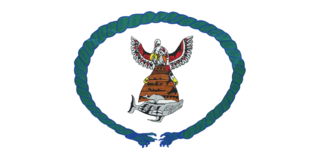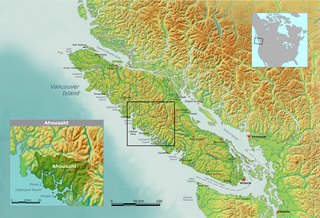Related Research Articles

The Nuu-chah-nulth, also formerly referred to as the Nootka, Nutka, Aht, Nuuchahnulth or Tahkaht, are one of the Indigenous peoples of the Pacific Northwest Coast in Canada. The term Nuu-chah-nulth is used to describe fifteen related tribes whose traditional home is on the west coast of Vancouver Island.
Nuu-chah-nulth, a.k.a.Nootka, is a Wakashan language in the Pacific Northwest of North America on the west coast of Vancouver Island, from Barkley Sound to Quatsino Sound in British Columbia by the Nuu-chah-nulth peoples. Nuu-chah-nulth is a Southern Wakashan language related to Nitinaht and Makah.
The Mowachaht/Muchalaht First Nations are a First Nations government on the west coast of Vancouver Island in the Canadian province of British Columbia. The Mowachaht/Muchalaht First Nations are a member nation of the Nuu-chah-nulth Tribal Council, which spans all Nuu-chah-nulth-aht peoples except for the Pacheedaht First Nation.

Tseshaht First Nation is an amalgamation of many tribes up and down Alberni Inlet and in the Alberni Valley of central Vancouver Island in the Canadian province of British Columbia. They are a member of the Nuu-chah-nulth Tribal Council which includes all other Nuu-chah-nulth-aht peoples except the Pacheedaht First Nation.
The Nuu-chah-nulth Tribal Council is a First Nations Tribal Council in the Canadian province of British Columbia, located on the west coast of Vancouver Island. The organization is based in Port Alberni, British Columbia.

The Ahousaht First Nation is a First Nation government based on the west coast of Vancouver Island in British Columbia, Canada. It administers the community of Ahousaht, British Columbia, which encompasses much of Clayoquot Sound. The Ahousaht are a member of the Nuu-chah-nulth Tribal Council. It is led by Chief A-in-chut Shawn Atleo and the Taayi Haw̓ił - Maquinna.

The Ehattesaht First Nation is a First Nations government covering about 660 km^2 on the West Coast of Vancouver Island in the British Columbia, Canada. It is a band that is one of the 14 Nuu-Chah-Nuulth Nations and is now a member of the Nuu-chah-nulth Tribal Council. In the modern-day, there are currently only 539 registered members as of October 2021. with a language that has been lost over the years as the British Columbia government states that there are only 52 speakers of the language.

Harriet Nahanee also known as Tseybayotl-t was an indigenous rights activist, residential school alumna, and environmental activist. She was born in British Columbia, Canada. She comes from the Pacheedaht who are part of the Nuu-chah-nulth, Indigenous peoples from the Vancouver Island. As a child, Nahanee attended both Ahousaht Residential School and Alberni Residential School, and would later testify about the horrible treatment she received there. She married into the Squamish (Sḵwxwú7mesh).

Marktosis, also spelled Maaqtusiis in the Nuu-chah-nulth language, is one of the principal settlements of the Ahousaht First Nation, located off the west coast of Vancouver Island in British Columbia, Canada, just southeast of the Hesquiat Peninsula on Flores Island. Accessible only by water or air, Marktosis is a small community predominantly composed of First Nations people from the Nuu-chah-nulth nation. Marktosis has approximately 900 residents. Marktosis Indian Reserve No. 15 was established around the site of the community and has 622 individuals living on the reserve in 2016.
Kingfisher was a sloop engaged in merchant trading out of Victoria, British Columbia, Canada to First Nations peoples around Vancouver Island and adjoining waters. During trading with the Ahousaht Nation, a part of the Nuu-chah-nulth in Clayoquot Sound late in 1864 the vessel was attacked and its captain, a Captain Stephenson, and three crew members were massacred. HMS Devastation, a small gunboat, was dispatched to the scene but due to overwhelming superiority of Ahousaht forces waited for reinforcements, which came in the form of the screw frigate HMS Sutlej and its fifty guns. Holding offshore from Marktosis, one of the main Ahousaht communities, Admiral Denman, commander of the vessel, demanded the surrender of Chapchah, who had masterminded the killings. When the residents refused, Denman opened fire on the village, destroying it. Subsequently, the village of Moyat and others were destroyed by shellfire and incendiary rockets from Sutlej.

Shawn A-in-chut Atleo, is an activist and politician, a former National Chief of the Assembly of First Nations in Canada. He also has served since 1999 as a Hereditary Chief of the Ahousaht First Nation, part of the Nuu-chah-nulth Nation based in British Columbia.
Ki-Ke-In, also known as Chuuchkamalthnii, Haa'yuups, and Ron Hamilton is a Nuu-chah-nulth cultural figure from the Hupacasath First Nation. His work includes sculpture, drawings, paintings, dance, song, writing, regalia and curatorial activities which document the ceremonial life of his people. A resident of Port Alberni, Ki-ke-in's exhibition of his own and historical Nuu-chah-nulth ceremonial curtains at the University of British Columbia formed part of the 2010 Vancouver Cultural Olympiad. A fisherman by trade, the resources he works with are Campbell River slate, wood, silver, gold, and ivory, often modelling his work on the sea serpent.

The Yuquot Whalers' Shrine, previously located on Vancouver Island, British Columbia, was a site of purification rituals, passed down through the family of a Yuquot chief. It contained a collection of 88 carved human figures, four carved whale figures, and sixteen human skulls. Since the early twentieth century, it has been in the possession of the American Museum of Natural History in New York City, but is rarely displayed. Talks are underway regarding repatriation.
The Esowista Peninsula is a peninsula in the Clayoquot Sound region of the west coast of Vancouver Island, British Columbia, Canada. The name was adopted in 1934 in reference to Esowista Indian Reserve No. 3. The name originally applied to the neck of land between Templar Channel and Browning Passage, centred at 49°08′N125°54′W to the whole neck of land from Grice Bay, Long Beach and Tofino. It was originally charted as Low Peninsula by the Royal Navy in 1860. Much of the peninsula is within the Pacific Rim National Park Reserve.
Esowista Indian Reserve No. 3, also known as Esowista 3, is an Indian reserve located on the Esowista Peninsula in the Clayoquot Sound region of the west coast of Vancouver Island, British Columbia, Canada. Located at the head of Wickaninnish Bay, just east of Schooner Cove, it is part of the group of reserves under the governance of the Tla-o-qui-aht First Nations of the Nuu-chah-nulth peoples. Its population in 2006 was 160.

Whaling on the Pacific Northwest Coast encompasses both aboriginal and commercial whaling from Washington State through British Columbia to Alaska. The indigenous peoples of the Pacific Northwest Coast have whaling traditions dating back millennia, and the hunting of cetaceans continues by Alaska Natives and to a lesser extent by the Makah people.
Tim Paul is a member of the Hesquiaht tribe from the Nuu-Chah-Nulth first nation. He is a master carver from Esperanza Inlet British Columbia. He was the senior carver at the Royal British Columbia Museum until 1992 when he left to oversee an indigenous education program for the Port Alberni school board on Vancouver Island.
Connie Watts is a mixed media artist and designer of Nuu-chah-nulth, Gitxsan and Kwakwaka'wakw ancestry. She lives and works on Coast Salish territory in Port Alberni and West Vancouver.
The Ahousaht Indian Residential School was a school within the Canadian Indian residential school system that operated in Ahousaht, British Columbia from 1904 to 1940. The school was located on Flores Island south of the Marktosis Indian Reserve #15, on land owned by the Women's Missionary Society.
References
- 1 2 3 4 "Nuu-chah-nulth artist's work featured in anti-discrimination exhibit | Ha-Shilth-Sa Newspaper". hashilthsa.com. 2013-04-04. Retrieved 2022-07-07.
- 1 2 Tepper, Leslie (2014). The Grand Hall: First Peoples of Canada's Northwest Coast. Library and Archives Canada. p. 100. ISBN 9780660202792.
- ↑ Sam Haiyupis / Bev Jack married in Ahousat, 31 May 1984, Ha-Shilth-Sa, p11
- ↑ Ha-Shilth-Sa, Klecko's, November 20th 2003, p18